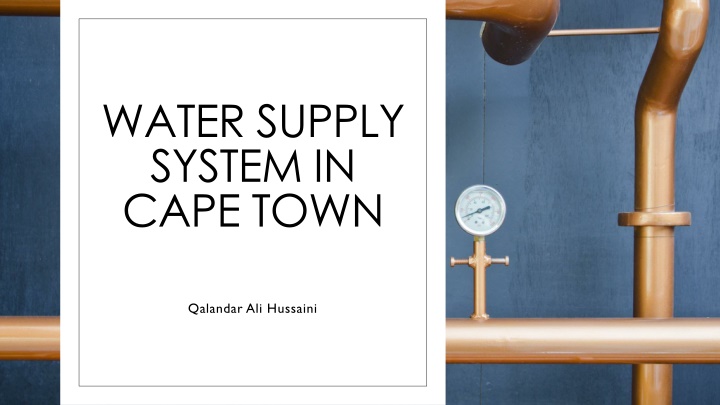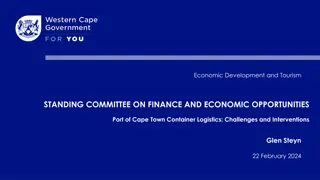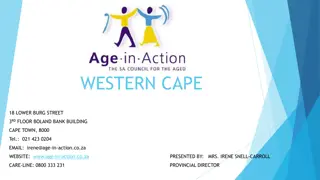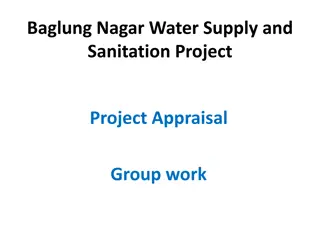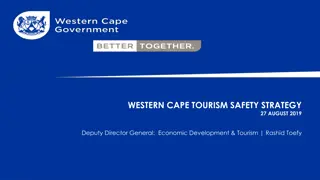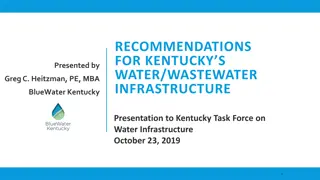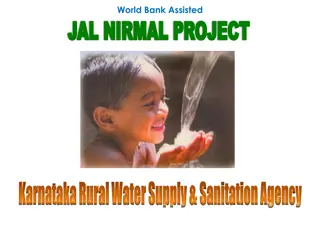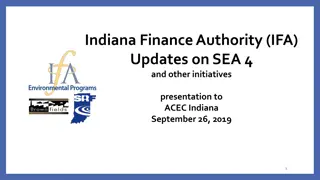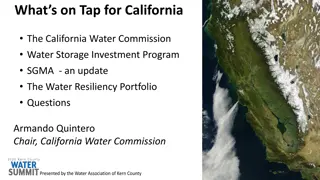Water Supply System in Cape Town: Overview and Infrastructure
Cape Town's water supply system, managed by the City of Cape Town's Water and Sanitation Department, serves over 4 million residents. The system relies on raw water from dams and reservoirs, with treatment plants ensuring water quality through processes like coagulation and disinfection. The distribution network comprises pipelines and reservoirs strategically interconnected to optimize water resources and meet the city's needs.
Download Presentation

Please find below an Image/Link to download the presentation.
The content on the website is provided AS IS for your information and personal use only. It may not be sold, licensed, or shared on other websites without obtaining consent from the author.If you encounter any issues during the download, it is possible that the publisher has removed the file from their server.
You are allowed to download the files provided on this website for personal or commercial use, subject to the condition that they are used lawfully. All files are the property of their respective owners.
The content on the website is provided AS IS for your information and personal use only. It may not be sold, licensed, or shared on other websites without obtaining consent from the author.
E N D
Presentation Transcript
WATER SUPPLY SYSTEM IN CAPE TOWN Qalandar Ali Hussaini
Location and Organization Cape Town is a major city in South Africa. It is located on the southwestern tip of the African continent, along the coast of the Atlantic Ocean. Cape Town is the capital of the Western Cape Province and is known for its stunning natural beauty, including Table Mountain and beautiful beaches. It's a popular tourist destination and one of the most well-known cities in South Africa. The water supply system in Cape Town is managed by the City of Cape Town's Water and Sanitation Department. With a 4,800 staff, this department is responsible for providing clean and safe drinking water to the residents of Cape Town, as well as managing wastewater and sanitation services in the city. They are tasked with ensuring the availability and quality of water resources for the population of Cape Town. The department has an annual operating budget of over USD 500 million (equivalent) and an annual capital budget of USD 180 million equivalent.
Population Served and Coverage Cape Town serves a population of over 4 million people within the city and its metropolitan area. The water supply services in Cape Town aim to cover most of the urban and suburban areas within the city and its surroundings.
Raw water sources and water treatment The city's primary raw water sources include dams and reservoirs in the Western Cape, such as the Theewaterskloof Dam and the Berg River Dam. Cape Town has 12 treatment works, ranging in treatment capacity from 3 Ml per day, at Constantia Nek to 500 Ml per day at the state-of-the-art Faure Treatment Works. Collectively, these plants provide a treatment capacity of approximately 1 600 Ml per day. How is the water treated? Coagulation and flocculation, Settlement (sedimentation), Stabilisation, Disinfection.
Drinking water production capacity, volume of distributed water, water use and storage capacity Cape Town is supplied by 14 dams with a collective capacity of approximately 900 000 Ml Most of this capacity is provided by six large dams: the Theewaterskloof, Vo lvlei, Berg River, Wemmershoek, and the Steenbras Upper and Lower dams.
Length and materials of drinking water distribution system The reservoirs operate as a system connected by pipelines, canals and tunnels that allows water to be transferred between reservoirs to help optimise water resources across the WCWSS (CCT, 2017b). For example, the Steenbras Upper Reservoir is kept as full as possible due to its high elevation, thus providing water distribution over a wider geographyic area. The distribution system consists of a network of pipes made of various materials, including concrete, PVC, and steel, which transport treated water to consumers through 660,000 water and sewer connections and 20,000 km of pipeline.
Recent and/or future developments As an incoming mayor post the drought crisis, my priority is to ensure that Cape Town s New Water Programme (NWP) delivers around 300 million liters (Ml) per day by 2030 from new alternative water sources. The City of Cape Town has launched its R120-billion infrastructure portfolio for economic growth, of which around 38%, or R45-billion, will be allocated to addressing water and sanitation infrastructure. This includes the upgrading of wastewater works, sewers to reduce spills, ensuring a healthy and dignified environment, and delivering new water sources daily.
Thank You Questions? Comments!
